
A cappuccino is an espresso-based coffee drink that is traditionally prepared with steamed milk including a layer of milk foam.

Caffè latte, often shortened to just latte in English, is a coffee drink of Italian origin made with espresso and steamed milk, traditionally served in a glass. Variants include the chocolate-flavored mocha or replacing the coffee with another beverage base such as masala chai, mate, matcha, turmeric or rooibos; alternatives to milk, such as soy milk, almond milk or oat milk, are also used.
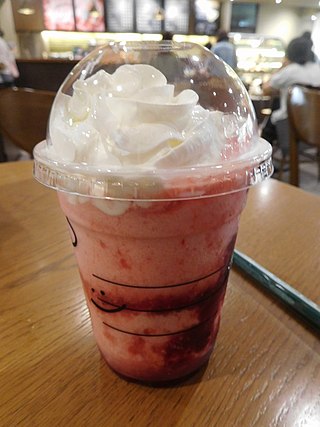
Frappuccino is a line of blended iced coffee drinks sold by Starbucks. It may consist of coffee or crème base, blended with ice and ingredients such as flavored syrups and usually topped with whipped cream and or spices. It may also include blended Starbucks refreshers. Frappuccinos are also sold as bottled coffee beverages in grocery stores, convenience stores and from vending machines.
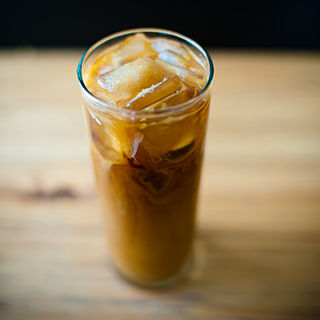
Iced coffee is a coffee beverage served cold. It may be prepared either by brewing coffee normally and then serving it over ice or in cold milk or by brewing the coffee cold. In hot brewing, sweeteners and flavoring may be added before cooling, as they dissolve faster. Iced coffee can also be sweetened with pre-dissolved sugar in water.

A caffè mocha, also called mocaccino, is a chocolate-flavoured warm beverage that is a variant of a caffè latte, commonly served in a glass rather than a mug. Other commonly used spellings are mochaccino and also mochachino. The name is derived from the city of Mokha, Yemen, which was one of the centres of early coffee trade. Like latte, the name is commonly shortened to just mocha.
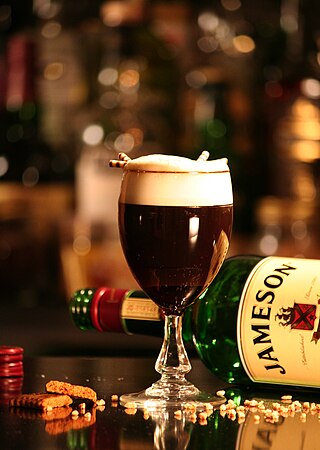
A liqueur coffee is a caffeinated alcoholic drink that consists of a shot of liqueur, mixed with coffee. It is typically served in a liqueur glass, often accompanied with cream and sugar. Coffee liqueur beverages are served in different fashions and can be found throughout many countries. One of the most popular liqueur coffee beverage is commonly known as Irish coffee. Liqueur coffee beverages are largely classified as cocktails as well as digestifs which are aimed at aiding the digestive process typically after a meal.
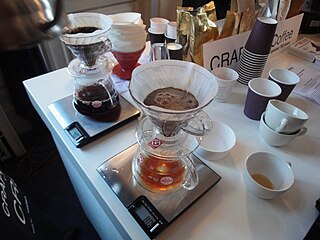
Coffee preparation is the process of turning coffee beans into liquid coffee. While the particular steps vary with the type of coffee and with the raw materials, the process includes four basic steps: raw coffee beans must be roasted, the roasted coffee beans must then be ground, and the ground coffee must then be mixed with hot or cold water for a specific time (brewed), the liquid coffee extraction must be separated from the used grounds, and finally, if desired, the extracted coffee is combined with other elements of the desired beverage, such as sweeteners, dairy products, dairy alternatives, or toppings.

Milk coffee is a category of coffee-based drinks made with milk. Johan Nieuhof, the Dutch ambassador to China, is credited as the first person to drink coffee with milk when he experimented with it around 1660.

Coffee culture is the set of traditions and social behaviors that surround the consumption of coffee, particularly as a social lubricant. The term also refers to the cultural diffusion and adoption of coffee as a widely consumed stimulant. In the late 20th century, espresso became an increasingly dominant drink contributing to coffee culture, particularly in the Western world and other urbanized centers around the globe.

An affogato, more traditionally known as "affogato al caffè", is an Italian coffee-based dessert. It usually takes the form of a scoop of plain milk-flavored or vanilla gelato or ice cream topped or "drowned" with a shot of hot espresso. Some variations also include a shot of amaretto, Bicerin, Kahlúa, or other liqueur.

Latte art is a method of preparing coffee created by pouring microfoam into a shot of espresso and resulting in a pattern or design on the surface of the latte. It can also be created or embellished by simply "drawing" in the top layer of foam. Latte art is particularly difficult to create consistently, due to the demanding conditions required of both the espresso shot and milk. This, in turn, is limited by the experience of the barista and quality of the espresso machine. The term also applies to other beverages containing milk foam, such as cappuccino and hot chocolate.
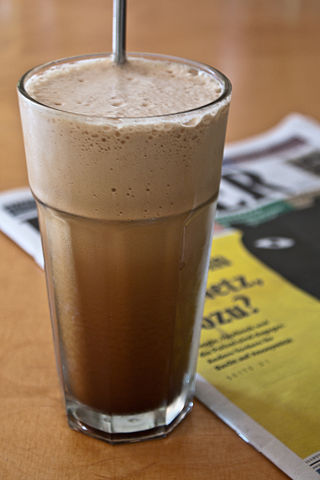
A frappé coffee, cold coffee, Greek frappé, or just frappé is a Greek iced coffee drink generally made from spray-dried instant coffee, water, sugar, and milk. The word is often written frappe. The frappé was invented in 1957 in Thessaloniki through experimentation by Dimitris Vakondios, a Nescafe representative. Frappés are among the most popular forms of coffee in Greece and Cyprus and have become a hallmark of postwar outdoor Greek coffee culture.

A bikini barista is a woman who works as a barista, preparing and serving coffee beverages, while dressed in scanty attire such as a bikini, lingerie or a crop top combined with bikini bottoms or hotpants. In the United States, this marketing technique originated in the Seattle, Washington area in the early 2000s. Similar phenomena have appeared in countries such as Chile and Japan since at least the 1980s.

Monorail Espresso is a coffeehouse in Seattle. It is notable as having been founded as the first espresso cart in the world. An espresso cart is a food cart from which a barista can make espresso. The business now operates as a walkup window with multiple locations.

The Nekrasovskaya line is the fifteenth metro line of the Moscow Metro. The first segment, between Kosino and Nekrasovka, was opened on 3 June 2019. The second segment was opened on 27 March 2020. City officials expect it to relieve passenger traffic on the Tagansko-Krasnopresnenskaya line once completed.
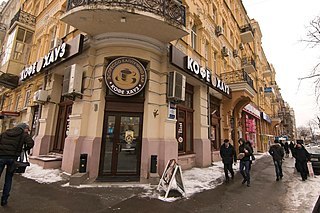
Kofe Khauz is a chain of coffee shops in Russia and Ukraine. The company has currently over 200 stores. It is based in Moscow and was founded in 1999.

Freken Bock is an art-cafe in Taganrog created near the parents' house and the monument of Faina Ranevskaya in 2009.
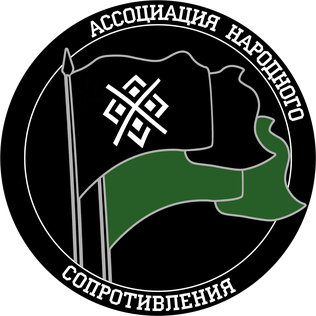
The Popular Resistance Association is a Russian national anarchist political organization. Founded in 2016 by a number of former activists of People's Will, NBP, and other movements
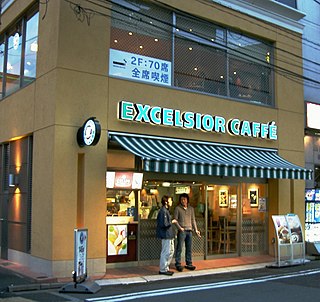
Excelsior Caffé is a Japanese chain of coffeehouses owned by Doutor Coffee. Established in 1999, it operates exclusively in Japan. The restaurant has an Italian style, hence its use of "caffé" instead of "café" in its name.



















